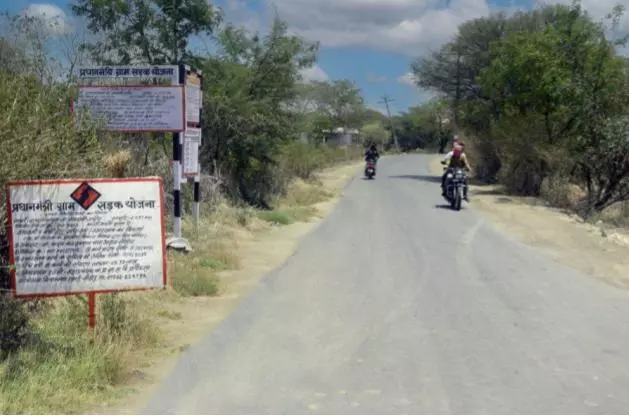
PMGSY woes: 22 years after launch, 31,000 km of rural roads remain on paper

India’s rural road connectivity programme has been floundering. Over the past 22 years, thousands of kilometres of roads sanctioned by the government under the Pradhan Mantri Gram Sadak Yojana (PMGSY), to provide connectivity to habitations in remote areas, just remain on paper.
And such inordinate delays in building these roads have naturally led to cost escalation of the projects. Also, the quality of the roads actually built under this programme remains rather poor and the maintenance of the roads below par.
PMGSY was launched to alleviate poverty by offering all-weather road connectivity to unconnected habitations. But 22 years later, thousands of habitations remain unconnected. Roads which do get laid often get washed away with the first monsoon showers and many develop cracks or become unusable due to poor construction quality.
Opinion | Hyderabad faces 3 disastrous consequences with scrapping of GO 111
The first chapter of the scheme, PMGSY I, was launched in 2000. Since then, three chapters have seen the light of the day. It has used up huge funds to the tune of nearly ₹3 lakh-crore till January this year.
Unbuilt roads
According to the latest data, of the sanctioned road length of 645,400 km under PMGSY I (the first chapter), nearly 25,000 km of roads are yet to be built. PMGSY I was to be completed by 2019 but then got extended till September 2022.
In total, over 31,000 km of rural roads under PMGSY I, PMGSY II and those sanctioned for Left Wing Extremism Areas (LWEA) are yet to be built, despite extension of deadlines and cost escalation. The roads under LWEA were sanctioned in 2016 across nine states: Andhra Pradesh, Bihar, Chhattisgarh, Madhya Pradesh, Jharkhand, Maharashtra, Odisha, Telangana and Uttar Pradesh. Only about 55 per cent of them have been built.
Why the delay?
The usual reasons have been put out by the Ministry of Rural Development (MoRD) to explain away the delays in PMGSY I and PMGSY II. These include the inability of state governments to ensure project completion and delays in obtaining necessary clearances for the road projects.
A Parliamentary Standing Committee (PSC examining the scheme – which has entered its third phase, PMGSY III, valid till March 2025 – has spoken sharp words against the MoRD for the tardy progress.
While PMGSY was initially a fully Central scheme, it was later converted into a Centre-state scheme where states were to contribute 40 per cent to the scheme’s funds (except north-eastern states which were to contribute 10 per cent).
Remarking that rural roads are “akin to the arteries of the body which connect the hinterland of the vast stretch of the country with ongoing development in every sphere of society”, the PSC asked the ministry to complete the construction of the remaining road length under PMGSY I and PMGSY II on “war footing”.
Also, it underlined the criticality of completing road projects in LWEAs besides completing the ongoing PMGSY III phase on time.
Quality issues
The panel lambasted the MoRD for poor quality of roads built under PMGSY as also their poor upkeep. And it has come up with an interesting suggestion – that the thickness of roads constructed under PMGSY be increased by 50 per cent to 30 mm (from 20 mm currently) to ensure better quality.
“Instances are galore wherein the attention of the committee has been drawn towards the poor road material used in the construction of roads at many places, which are not able to sustain the rigours of weather and traffic volume even for one season and are washed away with the onset of monsoon.”
Also read | Demand getting closer to COVID levels for perennially fund-starved MGNREGA
The committee has asked MoRD to ensure that poor quality material is not used in construction of rural roads.
Another peculiar issue has affected the quality of roads constructed under PMGSY –diversion of heavily laden commercial vehicles from national highways to rural roads. This leads to major damage to roads constructed under PMGSY. The ministry is now thinking of asking the Ministry of Road Transport and Highways, the National Highway Authority of India (NHAI) and other bodies to ensure maintenance of roads thus damaged.
Increasing the thickness of roads being built is also a step towards better quality roads and lower spends on maintenance.
MNREGA and PMGSY
One of the possibilities being studied by MoRD to connect those rural habitations which have not been covered under PMGSY at all is using some of the funds it gets for the Mahatma Gandhi National Rural Employment Act (MNREGA).
MNREGA is a rural employment guarantee scheme, the biggest welfare scheme of the Centre, under which rural households get work to build ponds, school sheds and, if the ministry agrees, roads to connect remote habitations. The MoRD has told the parliamentary panel that cross utilisation of funds under the two schemes for connecting more unconnected rural habitations is under consideration.
The parliamentary panel has also made several suggestions to widen the scope of PMGSY. One is to include roads which are 2 km in length instead of the current criterion of only building roads which are 3 km or more long. Another is stricter enforcement of a clause in the contract for building roads which puts the onus of their maintenance on contractors.


